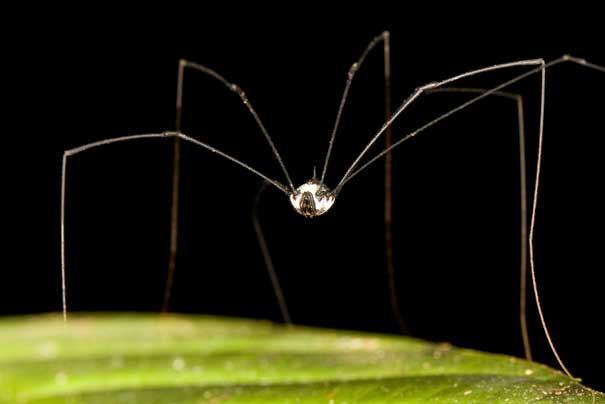Daddy Long Legs |
Dr Karl: My little 7-year-old daughter, Lola, shared a secret with me. "Did you know, Daddy", she said very solemnly, "Daddy Long Legs spiders are the most poisonous spiders in the world, but they can't hurt us because their fangs are too short to get through our skin". She knew this, because her 7-year-old friend India told her, and India heard it from Charlie, her 10-year-old sister - so it had to be right. But the kids were wrong in four ways, which has to be some kind of record for such a short sentence.
This myth is known around the world, not just in Australia. Most people know the Daddy Long Legs as a spider-like creature, roughly the size of a 20 cent coin, with a tiny body and long spindly legs spanning roughly the size of a 20-cent coin.
The first mistake that the kids made in their Daddy Long Legs story is that not all Daddy Long Legs are spiders - some are, and some aren't.
The Class Arachnida has many Orders in it. For example, there is an Order for spiders (Order Araneae), an Order for scorpions (Order Scorpiones), and an Order for opilionids (Order Opiliones).
Now, some Daddy Long Legs are opilionids. In this case, they are also called long legged harvestmen. At a casual glance, these opilionids look a little like spiders - but they are not spiders (because they do not belong to the Order Araneae). Opilionids have two eyes (not eight like the spiders do), one body section (spiders have two), and an abdomen that is clearly separated into segments (spiders' abdomens are unsegmented). They do not make silk, and they have a very different respiratory system from spiders.
However, in the Order of spiders, there is one real spider that looks like your classic Daddy Long Legs, so it gets called Daddy Long Legs. Its official name is Pholcus phalangoides.
Inside your house a Daddy Long Legs is probably a spider. But in dark damp places like the shed, it's more likely to be a harvestman.
Second mistake, "poisonous"?
Well, let me be a little pedantic (in the name of science). Strictly speaking, "poisonous" mean that the creature exudes poison from its skin or shell, from where it lands on your skin, and continues its nasty work. But if you talk about a creature that injects poison through your skin into the soft layers underneath, the correct word is "venomous".
But what the heck, the English language is continually changing, and I can let the kids get away with this one.
But the third mistake, "most poisonous" or "most venomous"? Well...
Opilionids do not have poison glands. They definitely do not have fangs through which to squirt their non-existent poison.
There are about 20,000 different species of spider on the planet, and only about 50 are venomous. The American Black Widow and the Australian Funnel Web are heavy hitters. The spider Pholcus phlangoides (or Daddy Long Legs) is a lightweight. It took many years for anybody to bother to get the toxin. You do this (as seen on the TV show, Mythbusters) by anaesthetising the spider with carbon dioxide, and then delicately applying tiny electric shocks to the appropriate bit of the spider. You then place a very thin glass pipe up against the fangs, and you can collect about two billionths of a litre of toxin per spider. When you do this a few hundred times, you get enough toxin to test - but it turns out to be incredibly weak, barely worthy of being counted as a poison.
The fourth mistake is about the fangs being too short to penetrate your skin.
Once again, the TV show Mythbusters actually measured the fangs (on one spider, which is a small sample size, but it's a start). Their spider-wrangler, Chuck Kristensen, found that the fangs were 0.25 mm long. But skin (especially on non-contact areas) can be as thin as 0.10 mm.
A Mythbusters host, Adam Savage (terrified of spiders) bravely put his entire arm into a perspex box filled with what seemed to be hundreds of the spider version of Daddy Long Legs. After what seemed an eternity, one bit him - and he lived, complaining only of a mild sting.
So why the bad rap for the Daddy Long Legs? Spiders have some very hairy image problems, and should cut back on the web spinning, and go all out on the spin doctoring...

Copyright © 2018 Australian Broadcasting Corporation
